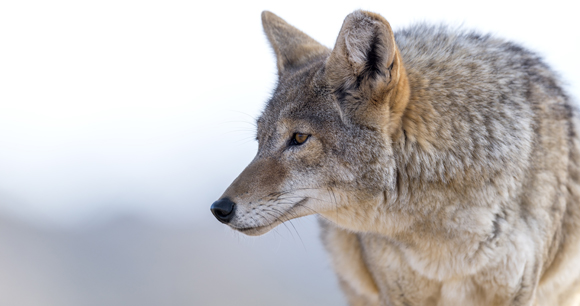by Rebecca Windell, who conducted this research as a graduate student at Colorado State University, where she worked with Dr. Stewart Breck, a faculty member at CSU and carnivore ecologist at the National Wildlife Research Center
Over the past century, coyotes have expanded their range, now inhabiting everywhere from Alaska to Mexico, and San Francisco to New York City. One consequence of their success has been an increase in conflict with both humans and other wildlife.

A variety of management tools are used to prevent and mitigate coyote conflicts. Such tools include fladry, which consists of a single strand of rope or electric fencing wire with red flags attached at even intervals. First developed for use with wolves, fladry is strung along the outside of protected areas (e.g., pastures), where the flags flapping in the wind disrupt wolf behavior and the electrified wire adds a shock to further discourage undesired predation.
Although coyotes have similar responses to fladry, their smaller size allows them to sneak between flags. As a result, the National Wildlife Research Center developed a new “coyote fladry” with narrower flag spacing. We tested this in a field setting for the first time using, in part, funds provided by a Christine Stevens Wildlife Award from AWI.
Our goal was to test coyote fladry and understand how long it could exclude coyotes from areas we wished to protect. Because coyotes have individual personalities that range from bold to shy, we suspected their response to fladry would be highly variable. To investigate this variability, we used methods that allowed us to understand how fladry influenced coyote use of protected areas and how they responded behaviorally to fladry. For the study, we cordoned off high-density prairie dog colonies. Such colonies are preferred habitats of coyotes in prairie ecosystems, where prairie dogs form a key part of their diet.
We did indeed find that coyote response to fladry was highly variable. In some plots, fladry excluded coyotes for the entire 60-day duration of our trials, and in others fladry kept coyotes out for as little as 9 days. On average, fladry excluded coyotes from protected areas for about 32 days. We also found that, in comparison to unprotected reference areas, the area inside fladry-protected exclosures was used 37 percent less during the first 30 days of our trial and, surprisingly, 60 percent less during the second 30 days of our trial. In addition, although fladry decreased coyote use, coyotes explored the periphery of fladry exclosures immediately after fladry installation (as shown by the tracks in the snow in the photo above).
Overall, fladry reduced coyote use within protected areas for at least 60 days; however, because coyotes appear to be attracted to fladry, it may do so in a way that is counterintuitive. Individual variation in coyote behavior is difficult to study but is a critical component of nonlethal coyote management and should be considered in the development and testing of future tools that aim to effectively, and humanely, manage wildlife.